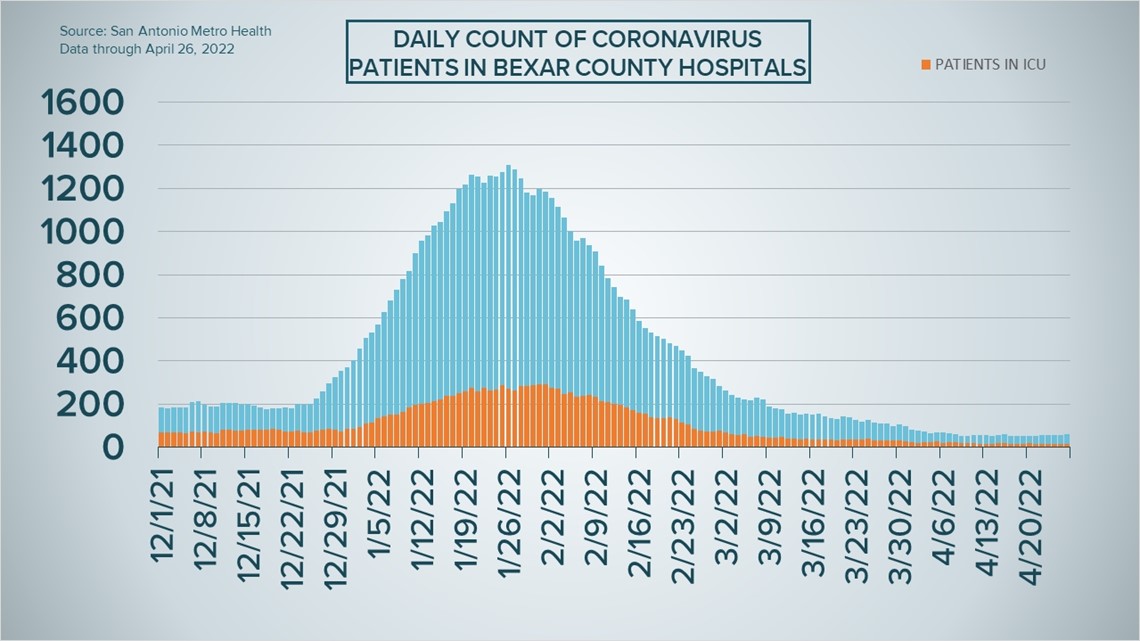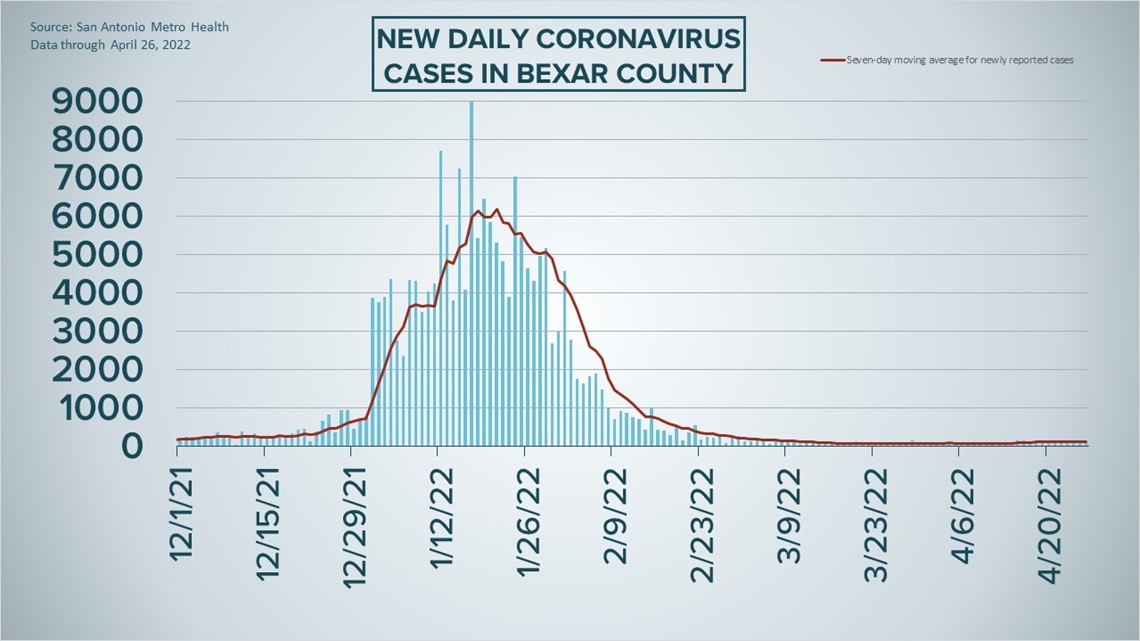SAN ANTONIO — Despite Tuesday yielding the San Antonio area's lowest count of new COVID-19 cases since April 17, Metro Health officials heightened the community's coronavirus risk level to "mild" for the first time since early December—and they say it's worsening.
It had been at the lowest threshold since March 8.
Eighty-six additional infections were reported in Bexar County, and the seven-day case average sits at 115 as of Tuesday. It's wavered every day for the last week as the county saw a stretch of new-case counts in the triple-digits, though it hasn't come close to seeing a surge like January's record-breaking wave.
April has brought an average of 90 new coronavirus cases a day, which is the same number as March but only a fraction of the nearly 4,800 daily infections reported in January.
Metro Health officials told KENS 5 they couldn't point to a specific factor when it comes to the recent uptick in infections, but added "we will closely monitor over the next few weeks." They also say being up to date on vaccinations remains "the best protection against the COVID-19 virus."
Local COVID-19 hospitalizations have also practically bottomed out, wavering in the 50s for most of April. The number of patients hospitalized for their symptoms stood at 60 on Tuesday, which is up 15% over the last week but down 28% since the start of the month.
Of those 60 patients, 14 were in intensive care and nine were using ventilators.
How Bexar County is trending




Vaccine Progress in Bexar County
The following numbers are provided by San Antonio Metro Health. A full breakdown can be found here.
- 1.443 million eligible Bexar County residents are fully vaccinated as of Monday, April 18.
- More than 505,000 eligible Bexar County residents have received their COVID-19 booster shot, as of Monday, April 18.
The CDC states that "when a high percentage of the community is immune to a disease (through vaccination and/or prior illness)," that community will have reached herd immunity, "making the spread of this disease from person to person unlikely."
The City of San Antonio breaks down the vaccination rates by zip code on Metro Health's Vaccination Statistics page.
Coronavirus in Texas
The total number of coronavirus cases in the state since the pandemic began grew by 2,585 on Tuesday, according to the Texas Department of State Health Services. That total includes 1,662 new confirmed cases and 923 new probable cases. More details can be found on this page.
Tuesday's figures bring the total number of Texans diagnosed with COVID-19 to more than 6.728 million.
An additional 15 Texans have died from virus complications, meanwhile, raising the statewide death toll to 86,498.
Coronavirus symptoms
The symptoms of coronavirus can be similar to the flu or a bad cold. Symptoms include fever or chills, cough, shortness of breath or difficulty breathing, fatigue, muscle or body aches, headache, new loss of taste or smell sore throat, congestion or runny nose, nausea or vomiting, and diarrhea, according to the Centers for Disease Control.
Most healthy people will have mild symptoms. A study of more than 72,000 patients by the Centers for Disease Control in China showed 80 percent of the cases there were mild.
But infections can cause pneumonia, severe acute respiratory syndrome, kidney failure, and even death, according to the World Health Organization. Older people with underlying health conditions are most at risk.
Experts determined there was consistent evidence these conditions increase a person's risk, regardless of age:
- Chronic kidney disease
- COPD (chronic obstructive pulmonary disease)
- Obesity (BMI of 30 or higher)
- Immunocompromised state (weakened immune system) from solid organ transplant
- Serious heart conditions, such as heart failure, coronary artery disease, or cardiomyopathies
- Sickle cell disease
- Type 2 diabetes
- The CDC believes symptoms may appear anywhere from two to 14 days after being exposed.
Human coronaviruses are usually spread...
- Between people who are in close contact with one another (within about 6 feet).
- Through respiratory droplets produced when an infected person coughs, sneezes or talks. These droplets can land in the mouths or noses of people who are nearby or possibly be inhaled into the lungs.
- Some recent studies have suggested that COVID-19 may be spread by people who are not showing symptoms.
Help stop the spread of coronavirus
- Stay home when you are sick.
- Eat and sleep separately from your family members
- Use different utensils and dishes
- Cover your cough or sneeze with your arm, not your hand.
- If you use a tissue, throw it in the trash.
Find a Testing Location
City officials recommend getting a COVID-19 test if you experience fever or chills, cough, shortness of breath or difficulty breathing, fatigue, muscle or body aches, headache, new loss of taste or smell, sore throat, congestion or runny nose, nausea or vomiting, or diarrhea.
Here's a Testing Sites Locator to help you find the testing location closest to you in San Antonio.
Latest Coronavirus Headlines
- CDC estimates 3 in 4 kids have had COVID
- Vice President Kamala Harris tests positive for COVID
- Administration expands availability of COVID antiviral pill
- Beijing to mass-test most of city as COVID-19 cases mount
- VERIFY | It is possible that the XE COVID-19 variant found overseas is already in south Texas?
- CDC: COVID was 3rd leading cause of death in US again for 2021
- UK patient had COVID-19 for 505 days straight, study shows
- Uptick in COVID cases push campuses to reinstate mask mandates
- Texas gubernatorial candidate Beto O'Rourke tests positive for COVID-19

